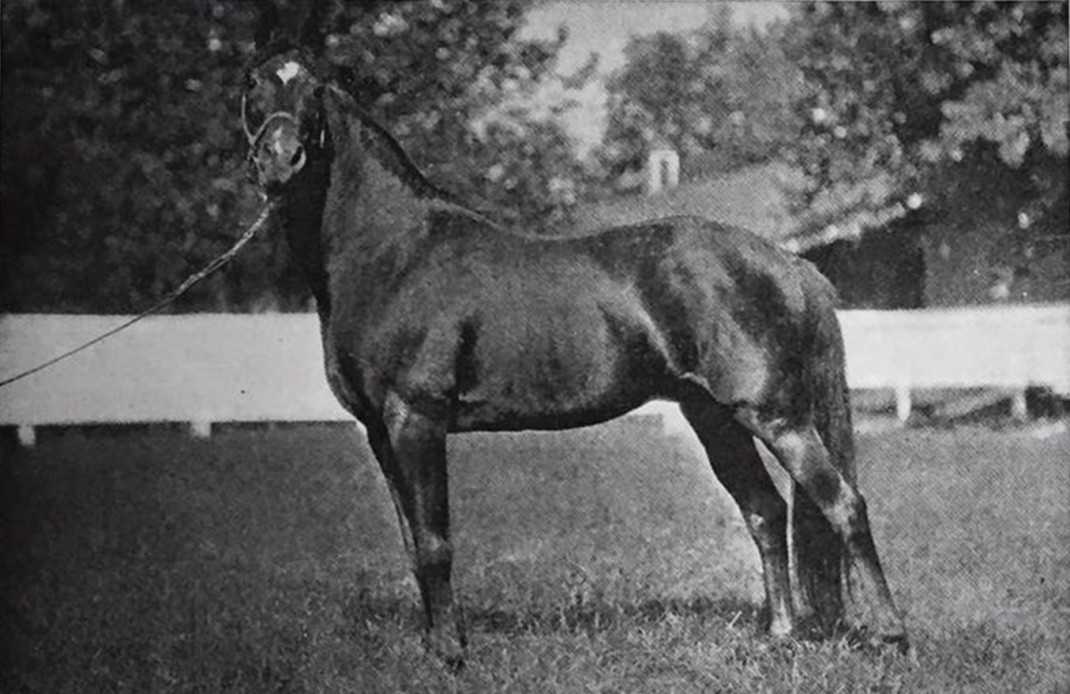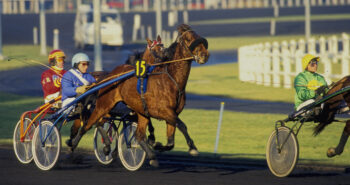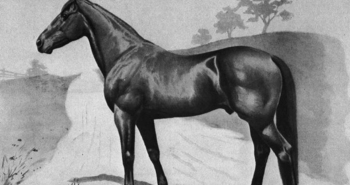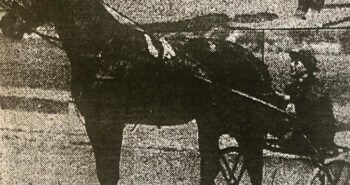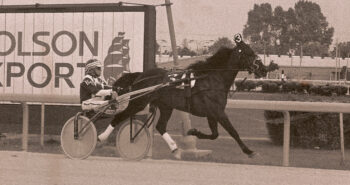Struggling to stay sound, he made just a few starts in his career but impressed mightly both by his capacity and his physique. Guy Axworthy then went on to get revenge at stud by becoming one of the first superstar stallions.
Bred by John H Shults, Guy Axworthy was assigned to Tommy Murphy and in winter training at Savannah at 2. The colt was identified as one of “a pair of baby trotters, 2-year-olds, that are most promising”, the other being Flying Axworthy. That July, Guy Axworthy was reported to have worked out in 2:20 and a quarter in 32 seconds. His talent should not have come as a surprise. Guy Axworthy’s sire Axworthy had plenty of talent and early speed, but struggled with his feet. While Guy Axworthy’s paternal pedigree is seen as excellent, his maternal side is often dismissed as of unknown or average quality. Nothing is further from the truth, however.
Bred by William Corbitt at the San Mateo Stock Farm in California, Lillian Wilkes had a short but excellent career on the track. After winning her first race, at the new track in Napa on Aug 15, 1898, the reporter in the Breeders and Sportsman wrote that “a better gaited trotter was never seen on any race track.” She then defeated the world champion Sunol – the only loss anybody ever inflicted on Leland Stanford’s exceptional mare. Lillian Wilkes won that race fair and square, too, grinding down Sunol in the last three heats. Moreover, her 2:17 3/4 (1.25,6) winning time was a world record for 3-year-old fillies. Later in the season she severe sprained a front foot and was laid up for the season. She never made it back to the track.
A short career
However, it would be a long time before the talented colt started in a race. The talented colt struggled with his feet and trialed in 2:23 3/4 (1.29,3) at 2, but his race debut came over two years later, on Oct 4, 1906. The newspaper reports from that day stated that “Tommy Murphy’s good thing in the 2:14 trot was a handsome stallion called Guy Axworthy, a 4 year old which is slated to succeed his sire in the stud. Belle Isle was favorite at even money against the field and took the opening heat in 2:13 (1.22,7), Guy Axworthy finishing eighth. But in the second mile Murphy sent him away and soon had a favorable position from which to make his drive. Belle Isle led to the half in 1:05 and at this point Guy Axworthy was fully three lengths back. The official time of the last half was 1:03 3/4, making the mile 2:08 3/4 (1.20,0). Separately timed, Guy Axworthy trotted this half mile in 1:02 1/2 and he stepped the homestretch quarter in 30 1/2.
Then it looked to be all over, but in the succeeding miles Axworthy broke on the backstretch and never was in at the finish, Belle Isle winning in 2:11, 2:11 1/4 (1.21,4, 1.21,6). Guy Axworthy’s mile is the best for the year by a 4 year old trotting stallion. He is out of Lillian Wilkes 2:17 3/4 (1.25,6) and, although beaten today in his first race, he is a classy nag and is expected to trot 2:05 next season.”
A magnificent animal
Guy Axworthy’s 2:08 3/4 turned out to be a new 4-year-old record. Winning a single heat and finishing second in the race was was also as good as it got on the track. The colt disappointed in the 2:20 class eight days later, and that was the end of his very short career. Still, even though he didn’t appear a lot on the track, Guy Axworthy managed to impress those two saw him. In an article in the Dec 28, 1938, Harness Horse, John Hervey wrote “when I saw him racing, as a four‑year-old, he was a slim, patrician colt, of great beauty and an airy, flying gait remarkable at once for its buoyant knee‑action and its scope and freedom. How well I recall the day he took his record! He finished the heat in superb, slashing style and, in action, gave the impression of a much bigger horse than he really was. Murray Howe and myself were watching the heat together and after the announcement we wended our way to the paddock beneath the old Lexington grandstand to get a closer glimpse of this brilliant colt that we never had seen before.
He was being given his breathing‑spell in the open, outside his stall, with Tommy Murphy standing by in his colors, and for a moment I stood almost transfixed at the magnificent sight that Guy Axworthy presented. He had been stripped of his harness and boots and a hot wash was being given him. His entire coat was wet with it and with sweat and he looked a dark brown instead of his normal rich red bay. His exquisite head was extended, with his nostrils flaring, eyes aglow with life and light and ears working nervously. Beneath his coat every vein, large and small, next his skin, stood out as if carven in relief upon a statue of bronze. His perfect symmetry, his slender limbs, so beautifully fluted and corded, his entire physique, combined in a picture such as one seldom sees. As we stood gazing at him for some moments, Murray said, turning to me: I don’t think I ever saw as fine a specimen of a trotting colt before. He’s a picture horse. You couldn’t fault him anywhere. Then, with his speed and that gait ‑ well, they say old man Shults is crazy about him. No wonder!”
Another thing Hervey pointed out was the family resemblance: “as is well known, he resembled his sire, Axworthy, not at all. As an individual, I could see nothing whatever of that horse about him. But, on the contrary, his resemblance to his paternal grandsire, Axtell, was astonishing. Axtell was a larger pattern, had more bulk and power, and behind he had those crooked hocks that he inherited from his sire, William L. Axtell was a beautiful horse, however, of very high quality, and the likeness between him and his grandson about the head and neck and back over the loins and hips was conspicuous. Axtell had, I would say, somewhat greater length of barrel, though not markedly so. Their colors were similar with the exception that Axtell was darker in hue, so much so that he is down officially as a brown, while Guy Axworthy was a bay. But Axtell’s coat was full of warm, red pigment—he was what we used to term a “rosewood bay,” while Guy Axworthy was a deep “blood” bay.”
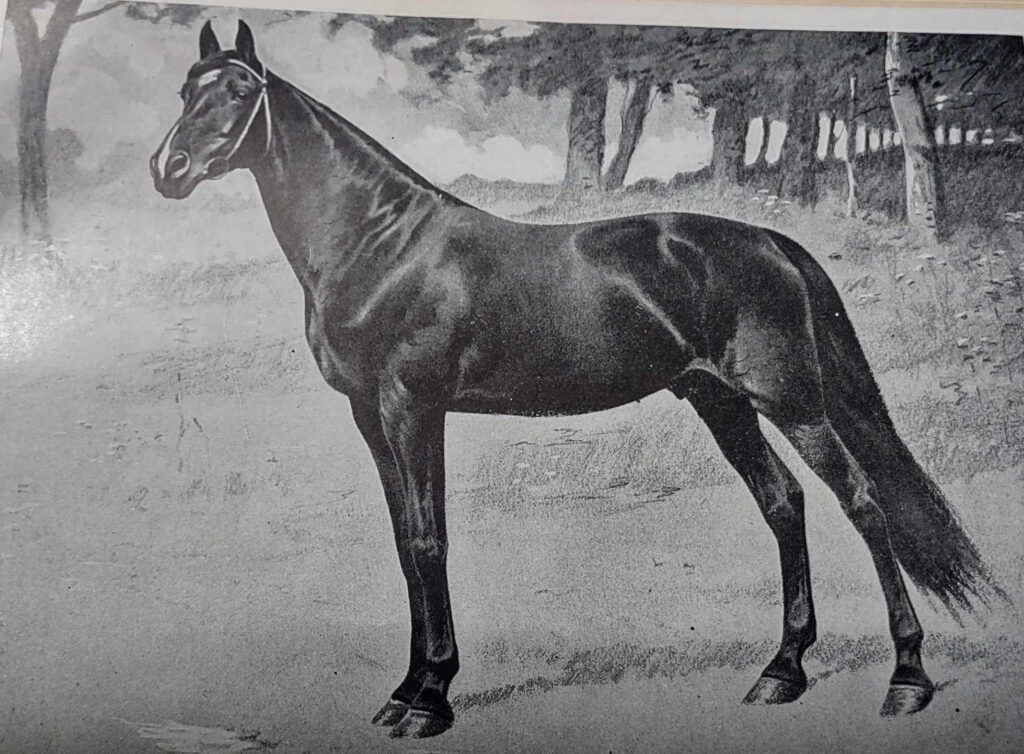
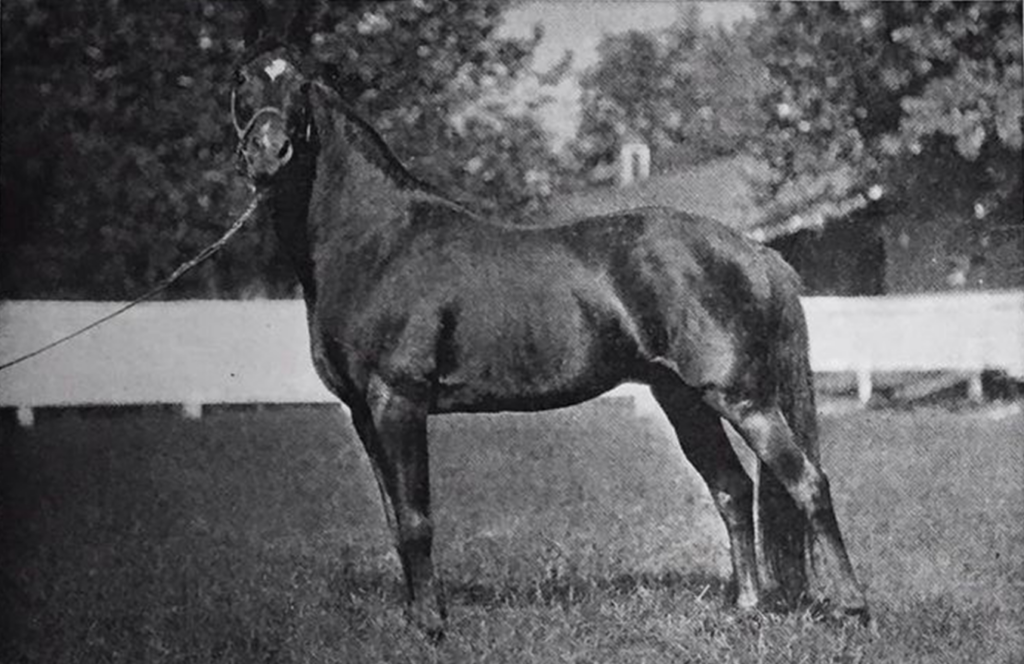
Almost sold to Russia
In the autumn of 1906, John Shults sold Axworthy and promoted Guy Axworthy to the premier stallion of his Shultshurst farm. The following autumn, Shults decided to sell Guy Axworthy. Though it may seem plain weird to sell the farm’s premier sire after just one season – especially since he had stated on numerous occasions that Guy Axworthy was an improvement over his sire – Shults rated another Axworthy son, Olcott Axworthy 2:08 1/2 (1.19,9), just as highly as the outgoing stallion. Guy Axworthy was then sold at the 13th Old Glory auction at Madison Square Garden on Nov 27, 1907. Prior to the auction, the press speculated that “the foreigners will likely buy Guy Axworthy 2:08 3/4.” After lively bidding the colt said on American hands, being bought by New Yorker Abe Garson, acting on behalf of William Bradley, for $8,100. The trotter could have ended up in Russia, though. The underbidder was Lon McDonald, acting on behalf of Frank Caton, the American based in Moscow. In hindsight, US trotting came very close to losing one of its best stallions in history at that point.
The following year Guy Axworthy stood stud at his new owner’s newly established Ardmere Farm, located at Raritan, NJ, together with Todd, another Bradley purchase at the Old Glory auction. While Todd’s service fee was placed at $200, Guy Axworthy was available for $100. The following summer, on May 17, 1908, tragedy struck when Todd died. This left Guy Axworthy the head of Bradley’s farm. As Bradley wanted a tried sire spearheading Ardmere he went out and paid – or maybe overpaid is the correct term – $40,000 for Todd’s famous sire Bingen. The latter was as an exceptional sire, but as it turned out, he would be eclipsed at stud by Guy Axworthy.
In 1909, Guy Axworthy was put back in training with the express purpose of lowering his record. He never made it back to the track, but his name stayed in the news thanks to a daughters from his crop. Muda Guy, by Muda S, a sister to Nancy Hanks, was the first three-year-old to take a record below 2:25 when she won in 2:22 1/4 (1.28,4) at Philadelphia in early July 1909. At the end of September she trotted exactly ten seconds faster, 2:12 1/4 (1.22,2), when she won the second heat in her race at Allentown. This was a new world record for three-year-old filly trotters at a half-mile track. In 1911, Muda Guy lowered her record to 2:09 (1.20,2). That year saw the birth of Guy Axworthy’s first superstar. That was Lee Axworthy 1:58 1/4 (1.13,5), the only trotter to beat Peter Volo in a race. Lee Axworthy was bred by Ardmere but was born at Walnut Hall Farm in Kentucky as they had acquired his dam Gaiety Lee for $2,500 in early 1911. Unfortunately, Lee Axworthy died early in 1918, only seven years old.
Moving around a lot
In early 1912 Senator Joseph Weldon Bailey acquired a half interest in the stallion and Guy Axworthy was then moved to Fairland Farm near Lexington in the Bluegrass state. It was a remarkable turnaround by Bailey; the previous year he had decided to get out of the game and disposed of much his stock, but it didn’t take too long for him to regret his decision. He then bought several horses at the Old Glory auction in November 1911 before acquiring Guy Axworthy a little later.
While Bailey quickly got back in the game, it was the other way around for Bradley. The wealthy New Yorker had surprisingly entered the standardbred world when he purchased Major Delmar for $12,000 and George G for $10,000 at the Fasig-Tipton sale in May 1907. He then spent a lot of money to build up Ardmere, but lost the interest soon enough. In March 1912 he announced he was selling all his trotting stock, and one newspaper sarcastically remarked that “hobbies with Bradley, like many men, do not last long. Bradley has turned his attention to the breeding of mules, and will use Ardmaer farm as a mule nursery.” Buyer of the stock, paying $100,000, was another New Yorker, David M Look, who shortly before had bought Castleton Farm. Guy Axworthy was not part of this deal, though, as he was part-owned by two men, and he was separately sold at the 1912 Old Glory auction. There he was purchased in full by Senator Bailey for $4,200.
However, to rewrite a previous quote, “hobbies with Bailey, like many men, do not last long.” In early 1914, Bailey announced the disposal of his stud – again. Guy Axworthy was one of many sold at the Midwinter auction at Madison Square Garden in February that year. The then-12-year-old stallion was purchased by Hunter C Moody for $2,100. Moody didn’t expect to buy the stallion at such a young price – Guy Axworthy was expected to fetch $8-10,000 at the sale – and the following day the colt had yet another new owner. According to the Lexington Herald-Leader, “Moody said last night that he regretted selling the horse, but that as he had already made an agreement to have J Malcolm Forbes and Mainleaf at his place he did not think it would have been practicable to have had a stallion of his own. Had he brought the horse home he would have been the second man to ever have three trotting stallions as fast under one management or ownership at the same time, the other man being J Malcolm Forbes, who at one time had Bingen, Peter the Great and Arion.” The new owner was Leo Ottinger and Jacob Ruppert and their Hunter River Stock Farm in Poughkeepsie.
A forever home in Kentucky
Two years later, however, Ruppert died. As a result, Guy Axworthy was consigned to his third Old Glory auction in November 1916. Now the demand was big, and it took $20,000 for Walnut Hall to secure the stallion. The move to the famous Kentucky nursery allowed Guy Axworthy to fulfill his immense stallion potential. Like fine wine, Guy Axworthy seemingly got better and better at stud with age. His last crop contained Lord Jim, winner of the 1934 Hambletonian. Prior to that he had also sired the first two Hambletonian-winners in Guy McKinney and Iosola’s Worthy in 1926 and 1927 respectively. The latter two also won the Kentucky Futurity – something also accomplished by Arion Guy in 1920, Mr McElwyn in 1924 and Aileen Guy in 1925.
It was usually daughters of Peter the Great that brought out the best in him at stud, but not always. From his last crop at Hudson River he produced Arion Guy 1:59 1/2, whose dam Margaret Parrish was by Vice Commodore, a son of Bingen. Mr McElwyn, Lord Jim, Guy Fletcher, Aileen Guy, Iosola’s Worthy, Guy Day, Sturdy, Jane Revere and Guy Bacon were all out of Peter the Great mares. However, Guy Axworthy also produced well with McKinney, his son Zombro and the latter’s son San Francisco, as illustrated by Guy McKinney, Guy Richard, High Noon and San Guy. One other son of Guy Axworthy worth mentioning is Guy Abbey, known as the sire of Greyhound.
Guy Axworthy died on Jul 3, 1933. After his death, a life-size bronze statue was unveiled at Walnut Hall Farm. Today it marks the entrance to the farm’s cemetery.
guy axworthy
Bay colt born in Port Chester, NY in 1902. Died in Lexington, KY on Jul 3, 1933.
Axworthy – Lillian Wilkes (Guy Wilkes)
2 starts: 0-1-0 – 4, 2:08 3/4 (1.20,0)
Breeder: John H Shults
Owners: John H Shults, WIlliam Bradley (Ardmere Farm) – William Bradley and Joseph Weldon Bailey – Joseph Weldon Bailey (Fairland Farm) – Hunter C Moody – Leo Ottinger and Jacob Ruppert (Hudson River Stock Farm) – Walnut Hall Farm
Trainers: John Cheney and Tommy Murphy
Drivers: John Cheney and Tommy Murphy
Grooms: –

